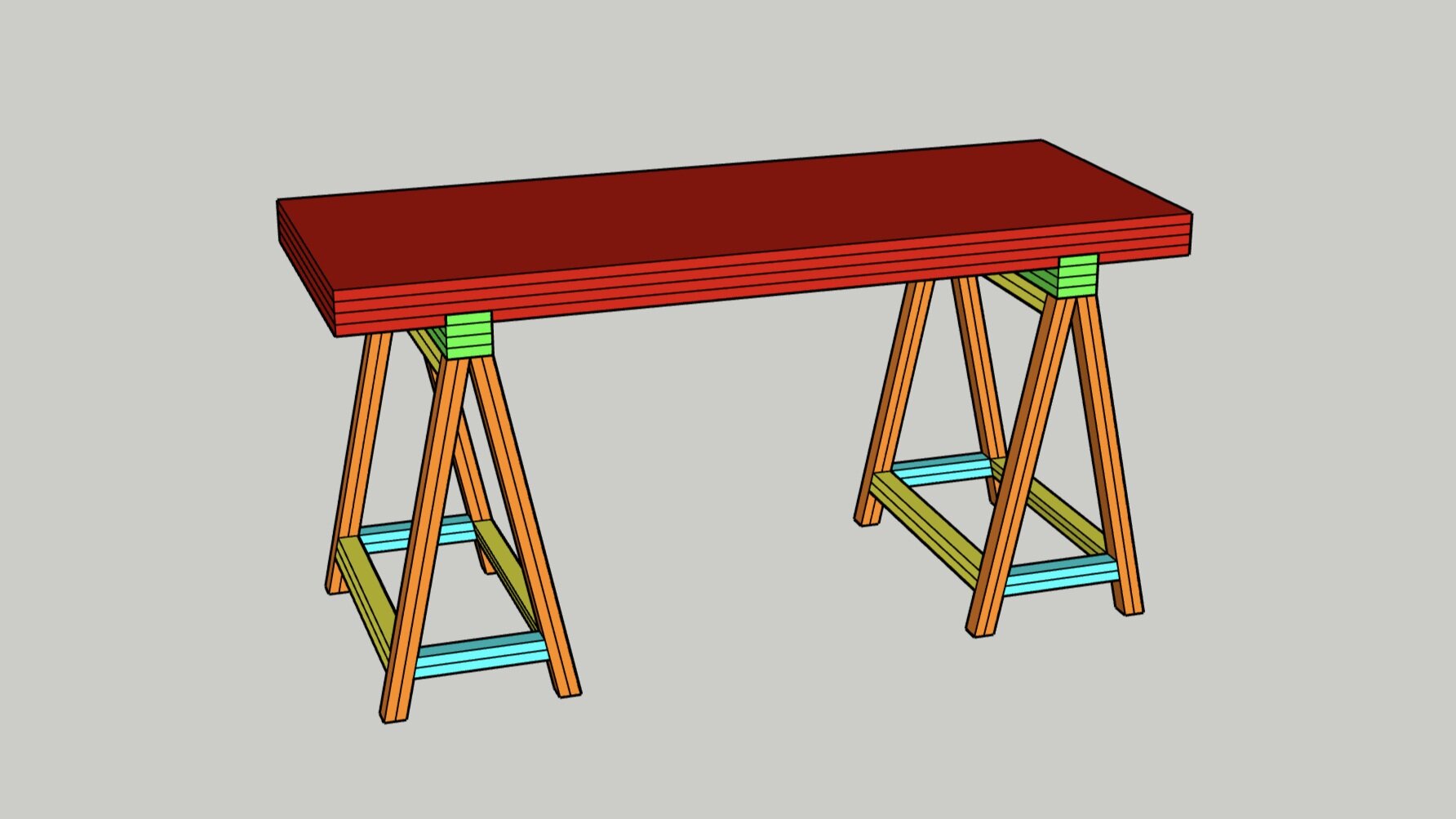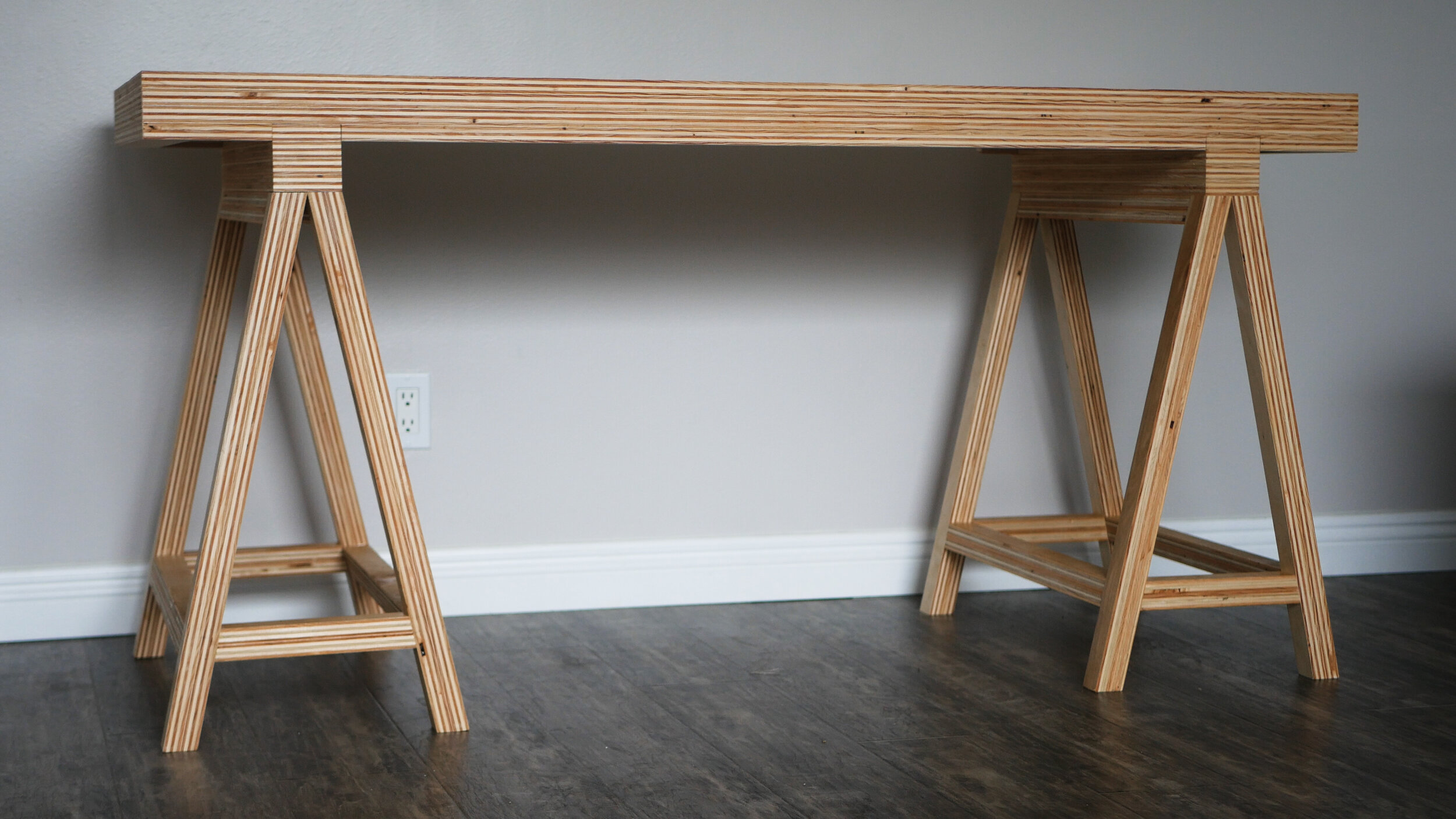We have a third bedroom that we’ve been wanting to convert into a home office since we bought our house. Due the COVID-19 virus, we are working from home indefinitely. So we saw this as an opportunity to begin building our office, starting with a really fun modern plywood desk. Everything was designed in the free version of Sketchup!
Thanks for checking out the article and video!
Free SketchUp Model for Download
MATERIALS
1 x 4' x 8' x 3/4" Maple Plywood
1 x 2' x 4' x 3/4" Maple Plywood
TiteBond II Wood Glue: http://amzn.to/2peRFus
1" Brad Nails
1/2" Dowel
Shellac + Foam Brush
TOOLS
SAWSTOP Contractors 30” Saw: https://amzn.to/2Luh91q
Table Saw Sled: https://amzn.to/2t2qVjD
Miter Saw: https://amzn.to/2lmqIHy
Brad Nailer: https://amzn.to/2Uz6tCI
Impact Driver: http://amzn.to/2q1l5wn
Orbital Sander: https://amzn.to/2ALtz16
ROCKLER ½” Dowelling Jig: https://amzn.to/2n1nt5W
KREG K5 Pocket Hole Jig: http://amzn.to/2qb8S7t
Squeeze Clamps
Tape measure, speed square, etc.




I love our third bedroom - in fact, I wish it was our master bedroom, but it’s not set up that way. The room has a great bay window and awesome natural light. I hopped into SketchUp Free to model the room and figure out the best sized desk for the room. The design of the desk is inspired by a modern minimalist looking saw horse bench and is 5’ wide x 2’ deep.
The first main step is breaking down your sheets of plywood against the design of the SketchUp File. It is my advice to always cut everything oversized a bit so you can firm up final dimensions down the road. With this being all plywood, it also helps to do this so you can create the cleanest final veneered edges without tear out.
Once all of my pieces were cut to rough length - I could begin assembly of all the leg components. For anything that would just get flushed up on the table saw, I used 1” brad nails and glue to secure it all together and move on to the next steps. For the longer stretchers that would eventually need a deeper angled cut through the table saw on both sides, I used glue and clamps and let those cure overnight.
After gluing and brad nailing, I could run each of my pieces through the table saw to flush up the plywood, taking off about 1/32” on each side. The table saw left an incredibly clean and flat cut.
I could then turn my attention to the desktop. Using the best looking pieces of the long “red” cuts, I could begin cutting to length for the front and sides of the desk. The corner would have a miter’d look to it, so after cutting a square end and then cutting to length, I could angle my miter saw at 45 degrees and cut the miters for the three sides.
I then glued and brad nailed the two side sets of plywood together, and squared up the outward facing edge on the table saw again. Such a clean look!
The legs of the desk were designed to sit recessed into the desktop itself exactly one 3/4” plywood layer thick.
To accomplish this design, I waited until I had my two outer edges glue and secured in place, as well as have the top piece of the leg cut and squared to its final size. I could then measure inward using the speedsquare and mark out exactly where I need to remove material from the final layer.
Then, sneaking up on the cut on my table saw, I cut it away. I could then use glue and brad nails again to secure the three pieces in place, using the leg pieces as proper spacers again to get it all exactly precise. Took a lot of time to make sure this was all correct, but It came out great!
I turned my attention to building each of the two sets of saw horse legs. The outside pieces were made up of two legs + a short stretcher, each that had a specific set of designed 12° angled cuts on them. I chose to wait to do all of the angled cuts at once so I only ever had to adjust my table saw blade once.
For assembly, I’m using 1/2” dowels to hold all of the major joints together. My $20 Rockler Dowel jig is perfect for this. I wish I had something a little more automatic, but it’s good practice mentally to figure out measurements, markings, and drilling precision. Each stretcher and leg received matching dowels.
I then used glue to assemble. Using the offcuts from the 12° angles allowed me to easily squeeze clamp everything together - always save the offcuts temporarily!
While the four legs dried, I went back to the table saw to cut my four long stretchers. This was the last of the 12° cuts to make - these were the pieces I didn’t put any nails into so I wouldn’t knick the table saw while cutting.
Before we could get to final assembly, I wanted to take the last of the long stretchers I cut in the beginning and attach three of them to the underside of the desk for rigidity and strength. I ripped those to their final width, drilled pocket holes, and then secured to the underside using glue and pocket hole screws.
One tip - the drill setting on the K5 jig for 3/4” will actually cause your screws to go through the other end of plywood which you don’t want for your desktop. I set it at 7/8” and it worked out great.
The next steps were a series of repeats. I sanded down the edges of any of the pieces I was about to assemble - just easier to do when flat. I then cut to length my final set of stretchers and drilled more dowels to connect everything together. Then, using glue and dowels and bar clamps, I pulled everything together, paying extra attention to the final orientation of all my pieces and that they were all angled properly. This ensure that when the legs sat upright, pieces were squared and/or parallel to the ground.
Before finishing, I wanted to do a few final steps, including sanding down all of the exposed edges of plywood, rounding over the corners with a screw driver (this is a great way to get rid of sharp edges and fold in the veneer without sanding it away - give it a try!), and then finally add the last part of the top of the leg to each saw horse base, and of course give the top a good quick sanding.
Then it was time for finishing. I added a shellac finish to all surfaces to protect the material, up the contrast of the plywood layers, but also to avoid yellowing or changing the color of the material too much.
All done! Can wait to enjoy this new desk in our ongoing home office renovation! I’m also looking now into what type of power or surge protector stuff I want to add to the desk underneath.
Thanks for checking out the project! Make sure you check out the video in the first step on my YT channel!
See you around!
Zach






























































